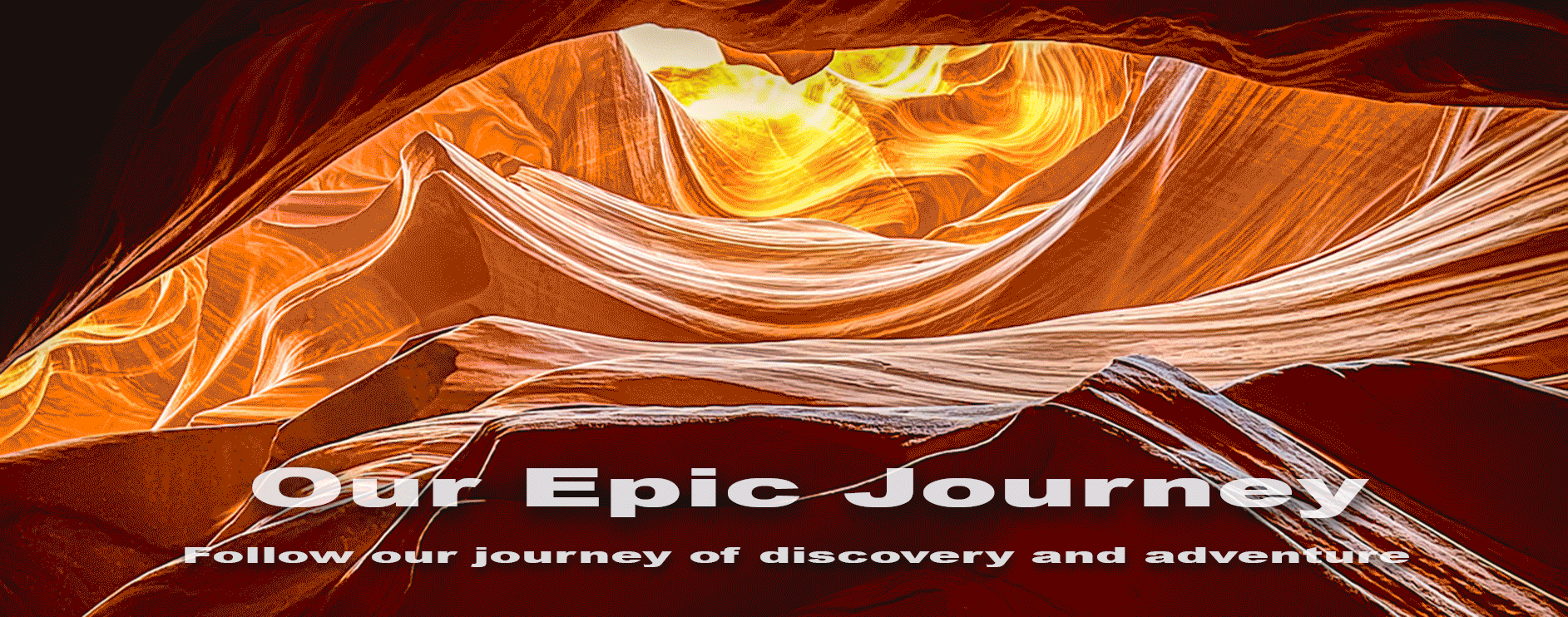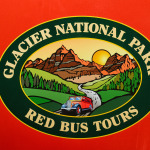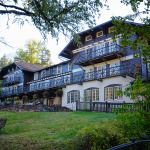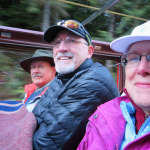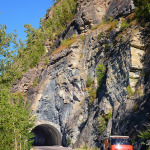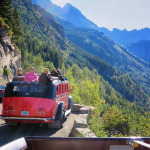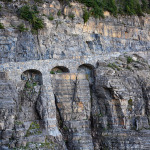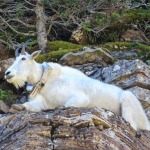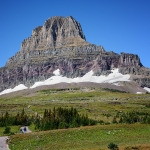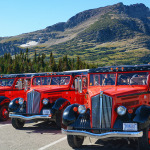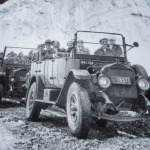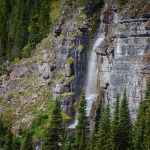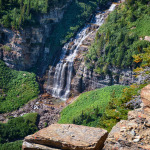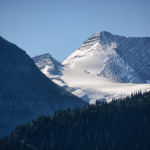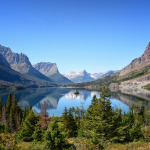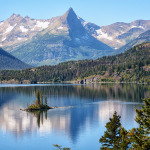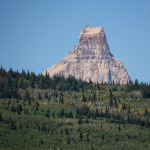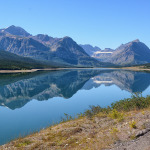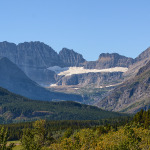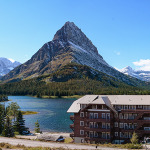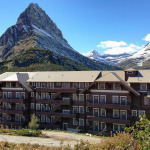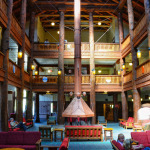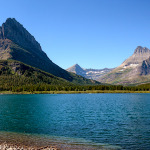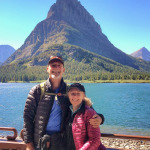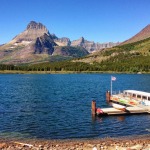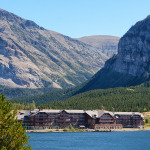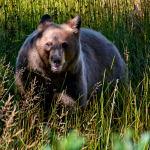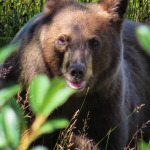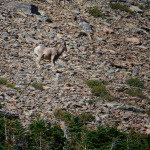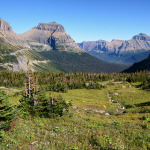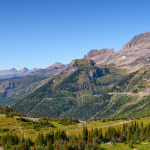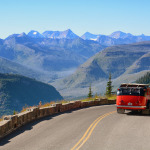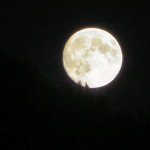Saturday, Sept 6th. A beautiful sunny day for a bus tour. We got up early to take the Red Bus Tour to Many Glacier, and we were picked up at the KOA at 8am. The Red Buses are a great way to see and learn more about Glacier National Park. The vintage 1930’s buses are part of the historic heritage of the Park. The roll-back tops are perfect for viewing the spectacular mountains and wild life, as we pop up like prairie dogs to take photos of all the magnificent sights. Since 1936, Glacier National Park’s fleet of 33 Red Buses, built by the White Motor Company of Cleveland, OH between 1936 and 1939, have been providing tourists unforgettable experiences touring through one of the most spectacular parks anywhere.
The drivers of the Red Buses are called “jammers”, the name carried over from the days when the buses had standard transmissions and the driver could be heard jamming the gears as they drove up and down the rugged mountain highway. Our “jammers” name is Russ, and he was very knowledgeable, we learned a lot from him today. Ford Motor Company’s restoration of the buses in 2001 will help to keep the Red Buses going for another 75 years. Our first stop was the Belton Chalet in West Glacier to pick up more people. It is the only hotel open all year, it was built in 1910-1911 by the Great Northern Railway with the Swiss Chalet architectural style. We picked more people up at Lake McDonald Lodge and finally started our tour on the Going-to-the-Sun Road about 9:30 with the top pulled back, it was very cold. Russ narrated stories to us as we drove through the Hemlock and Cedars following the shores of Lake McDonald, the largest lake in the Park, 10 miles long and a mile wide. We stopped at several pull offs along the way to view the majestic mountains from the Road. Every time the Red Bus stops we would jump up like prairie dogs and take photos. We pulled over to see a view of Big Woman Falls about 2 miles in the distance, it is always in the shadows and at this time of year there isn’t a lot of water flowing over the 560 ft drop because the falls are fed by melting snowfields and a remnant glacier on Mt Oberlin. We passed by the Weeping Wall, a natural waterfall that seeps out from the side of the Garden Wall and fed by snowmelt, there was not a lot of water flowing.
Just before we reached Logan Pass, Russ spotted some mountain goats lying on the hill above the road, our first sighting of many. Logan Pass, 6,646 ft, crosses the Continental Divide and is the highest point on the Going-to-the-Sun Road. We parked here for a break and went to see the Visitor Center and walk along the boardwalk behind the Center, to see the beautiful scenery of the mountains and wild flowers. As we left Logan Pass, Russ explained that this is the most difficult road to snowplow, up to 80 ft of snow can lie on top of Logan Pass. East of the Pass is the BIG DRIFT area where more than 100 feet of snow can accumulate, and it takes at least 10 weeks to plow the road in the spring to open by June.
We pulled over to view Jackson Glacier in the distance, the 7th largest of the remaining 25 glaciers in the Park, measured in 2005 at 250 acres. Glaciologist have stated that by the year 2030 many if not all of the glaciers in the Park may disappear completely. Our next stop was to get photos of St Mary Lake with Wild Goose Island in the middle and Little Chief Mountain rising at the west end of the lake. Amazing views of this lake with wonderful reflections of the mountains.
We arrived at Many Glacier Hotel, located on the east shore of Swiftcurrent Lake, for lunch with an hour to enjoy this old historic lodge. Many Glacier Hotel was constructed from 1914-1915 by the Great Northern Railway, it was considered the “Gem of the West”. It stands four stories tall with a Swiss Alpine theme inside and out, to promote the area as the “American Alps”. We ate lunch in the Swiss Room Lounge and then wandered through the hallways and four story lobby surrounded by balconies. The Hotel still maintains its historic character by not placing televisions in the guest rooms. There is also no internet or cell reception. The view from the porch is the most spectacular sight of mountains and the lake that you could imagine, I tried to capture it on video for you to enjoy.
At 2 o’clock we all climbed back on the Red Bus for our return trip. From this side of the Park Russ pointed out in the distance the Gem, the Grinnell and Salamander Glaciers. The highlight of our trip back was a black bear sighting by the side of the road. Russ was great he turned the bus around and drove down a dirt road to find the bear and we were all so excited when we saw him in the grass. Russ told many Indian Legends all the way back about the names of the mountains, lakes and the island in St Mary Lake. We thoroughly enjoyed our Red Bus Tour and would definitely recommend it for those who want to learn more about the Park not just the amazing views. We were dropped off at the KOA around 5:30 pm, in time to enjoy dinner and drinks around the campfire and watch the Super Moon rise over the mountains.
